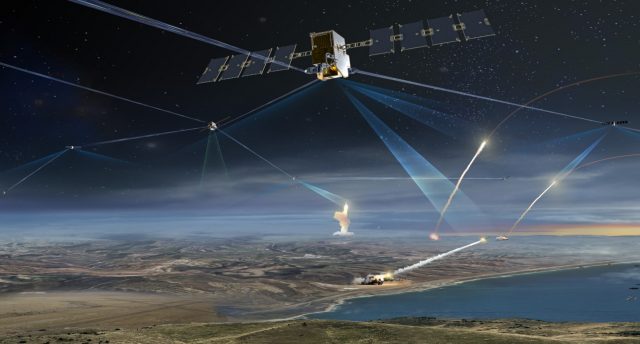The Space Development Agency (SDA) has awarded two prototype agreements with a total potential value of over $1.3 billion to Northrop Grumman and L3Harris for work on a hypersonic missile warning/missile tracking satellite layer.
The satellites that will built for the Tranche 1 (T1) Tracking Layer (T1TRK) will begin to launch in April 2025.
Once deployed in 2025, the T1TRK satellites will operate in up to four low-Earth orbital planes, interconnected with Tranche 1 Transport Layer satellites. Each will feature a wide field-of-view infrared sensor, three optical communications terminals, and a Ka-band payload for communications.
Each of the selected contractors will build a space segment consisting of two planes with seven space vehicles per plane – 14 satellites from each performer for a total of 28 satellites in four planes – to collect infrared data and provide network communications.
Both agreements also include a launch services segment for launch preparation, and a ground segment for operations and sustainment.
L3Harris is awarded a prototype agreement with a potential value of approximately $700 million and Northrop Grumman’ award has a potential value of approximately $617 million.
These prototypes will provide global and persistent indications, detection, warning, tracking, and identification of conventional and advanced missile threats, including hypersonic missile systems.
“The T1 Tracking Layer effort is a critical step toward building the National Defense Space Architecture,” said Derek Tournear, SDA director. “SDA is confident that selection of the L3 Harris and Northrop Grumman teams provides the best overall solution to accelerate delivery of a low-Earth orbit constellation with wide-field-of-view infrared sensors for a global missile warning and missile tracking capability in Tranche 1, on schedule. I’m pleased to see our industry partners building the marketplace necessary to quickly deliver new space capabilities to the warfighter.”
The Tranche 1 Tracking Layer will build upon the Tranche 0 Tracking Layer capabilities with targeted technology enhancements, expanded coverage, increased integration, established calibration processes, and greater production efficiencies. The Tracking Layer is focused on developing a global constellation of infrared missile warning and missile tracking satellites that integrate with the Transport Layer’s low-latency meshed communication network, enabling conventional and advanced missile tracking from proliferated low-Earth orbit.
The Tranche 1 Tracking Layer satellites will be flown out of SDA’s Operations and Integration Centers at Grand Forks Air Force Base, N.D. and Redstone Arsenal, Ala.
In fiscal year 2022 Congress provided SDA $550 million in additional funding to accelerate deployment of the Tracking Layer, with specific direction to demonstrate a space-based missile warning, tracking, and targeting capability in support of US Indo-Pacific Command.
The vision for the National Defense Space Architecture (NDSA) includes fielding a system that provides a resilient global capability to all combatant commands as rapidly and affordably as possible.
SDA published the Tranche 1 Tracking Layer solicitation on March 17, two days after the President signed the fiscal year 2022 appropriations bill into law. Leveraging Other Transaction Authority, SDA completed a competitive source selection and finalized the agreements within four months of the published solicitation.
“The speed with which SDA pursued this effort is commendable, given the severity of the hypersonic missile threat,” said Christopher E. Kubasik, L3Harris chair and CEO. “This prime contract is a testament to our growing impact in the space community, and affirms our strategy of being a Trusted Disruptor is gaining traction.”
“Northrop Grumman brings decades of proven experience in missile detection, identification, tracking and communication systems,” said Robert Fleming, Northrop’s vice president and general manager of the Strategic Space Systems Division. “We look forward to working with the Space Development Agency and our industry partners on the nation’s most pressing challenges in missile defense.”


























